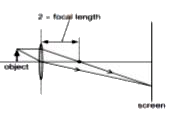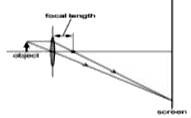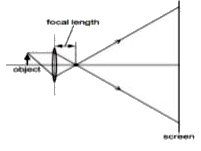Which diagram shows image formation of an object on a screen by a converging lens?




To determine which diagram shows image formation of an object on a screen by a converging lens, we can follow these steps:
Step 1: Understand the Concept of Image Formation by a Converging Lens
A converging lens (convex lens) can form an image by bending light rays that pass through it. For image formation, at least two rays of light from the object must converge at a point on the screen.
Step 2: Identify the Principal Axis
The principal axis is an imaginary line that passes through the center of the lens. It is important for determining how light rays behave as they pass through the lens.
Step 3: Analyze the Light Rays
For image formation:
- One ray should travel parallel to the principal axis and then refract through the lens to converge at a point.
- The second ray should pass through the center of the lens without deviating.
Step 4: Evaluate the Given Options
1. Option 1: Check if the light rays are correctly passing through the lens and converging on the screen.
2. Option 2: Ensure that one ray is parallel to the principal axis and the other passes through the center of the lens.
3. Option 3: Confirm that both rays converge at a point on the screen.
4. Option 4: Verify if the rays are meeting on the screen.
Step 5: Identify the Correct Diagram
After analyzing the options:
- Option 3 meets all the conditions for image formation: one ray is parallel to the principal axis, and the other passes through the center of the lens, converging at a point on the screen.
Conclusion
The correct answer is Option 3, as it accurately represents the image formation by a converging lens.
---
A converging lens (convex lens) can form an image by bending light rays that pass through it. For image formation, at least two rays of light from the object must converge at a point on the screen.
The principal axis is an imaginary line that passes through the center of the lens. It is important for determining how light rays behave as they pass through the lens.
For image formation:
- One ray should travel parallel to the principal axis and then refract through the lens to converge at a point.
- The second ray should pass through the center of the lens without deviating.
1. Option 1: Check if the light rays are correctly passing through the lens and converging on the screen.
2. Option 2: Ensure that one ray is parallel to the principal axis and the other passes through the center of the lens.
3. Option 3: Confirm that both rays converge at a point on the screen.
4. Option 4: Verify if the rays are meeting on the screen.
After analyzing the options:
- Option 3 meets all the conditions for image formation: one ray is parallel to the principal axis, and the other passes through the center of the lens, converging at a point on the screen.
The correct answer is Option 3, as it accurately represents the image formation by a converging lens.
Topper's Solved these Questions
- SAMPLE PAPER 2022BOOK - CBSE MODEL PAPERCHAPTER - SAMPLE PAPER 2022EXERCISE - SECTION - B
9 Videos
- SAMPLE PAPER 2022BOOK - CBSE MODEL PAPERCHAPTER - SAMPLE PAPER 2022EXERCISE - SECTION - C
4 Videos
- SAMPLE PAPER 2022BOOK - CBSE MODEL PAPERCHAPTER - SAMPLE PAPER 2022EXERCISE - ALTERNATIVE QUESTIONS(SECTION C)
4 Videos
- SAMPLE PAPER (MATHEMATICS STANDARD)BOOK - CBSE MODEL PAPERCHAPTER - SAMPLE PAPER (MATHEMATICS STANDARD)EXERCISE - PART - B
16 Videos
- SAMPLE PAPER 2022 TERM IIBOOK - CBSE MODEL PAPERCHAPTER - SAMPLE PAPER 2022 TERM IIEXERCISE - SECTION C
2 Videos
Similar Questions
Draw ray diagrams showing the image formation by a concave lens when an object is placed
(a) between focus and twice the focal length of the lens
(b) beyond twice the focal length of the lens
View SolutionDraw a ray diagram to show image formation by a concave lens.
View SolutionDraw a ray diagram to show the formation of a real magnified image by a convex lens. (In your sketch the position of object and image with respect to the principal focus of lens should be shown (clearly).
View Solutiona) Construct ray diagrams to illustrate the formation of a virtual image using i) a converging lens, and ii) a diverging lens.
b) What is the difference between the two images formed above?
View Solutiona) An object is placed 10 cm from a lens of focal length 5 cm. Draw the ray diagrams to show the formation of image if the lens is (i) converging, and ii) diverging.
b) State one practical use each of convex mirror, concave mirror, convex lens and concave lens.
View Solution(a) Draw a ray diagram to show the formation of image of an object placed between infinity and optical centre of a concave lens.
(b) A concave lens of focal length 15 cm forms an image 10 cm from the lens. Calculate (i) the object distance, (ii) the nature and magnification of the image formed.
View SolutionA student focuses the image of a well illuminated distant object on a screen using a convex lens. After that the gradually moves the object towards the lens and each time focuses its image on the screen by adjucting the lens.
(a) In which direction -towards the screen or away from the screen, does he move the lens ?
(b)What happens to the size of the image-does it decrease or increase ?
(c) What happens to the image on the screen when he moves the object very close to the lens ?
View SolutionMake lablled ray diagrams to ollustrate the formation of :
(a) a real image by a converging mirror.
(b) a virtual image by a converging mirror.
Mark clearly the pole, focus, centre of curvature and object in each case.
View SolutionDraw ray diagram showing the image formation by a concave lens when an object is placed at the focus of the lens.
View SolutionDraw ray diagrams showing the image formation by a concave lens when an object is placed
(a) between focus and twice the focal length of the lens
(b) beyond twice the focal length of the lens
View Solution
